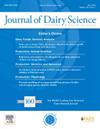基于反刍、活动和产奶量警报的自动健康监测与目视观察对牛群健康监测和性能结果的影响。
摘要
这项随机试验的主要目的是比较仅依靠自动监测系统警报的健康监测计划与仅依靠肉眼观察疾病临床症状来选择奶牛进行临床检查的计划中,接受临床检查并确诊患有临床健康疾病(CHD)的奶牛比例。另一个目的是比较这些健康监测计划对产奶量、牛群退出动态(即奶牛出售和死亡)以及首次分娩繁殖结果的影响。参加实验的泌乳荷斯坦奶牛(n = 1,204 头)颈部安装了自动监测系统(HR 标签;默克公司)的传感器,该系统可根据反刍时间和活动发出健康警报。自动奶量计(MM27BC,利拉伐)每天监测三次奶产量。奶牛按奇数、密闭期饮食进行分群,并按上一个泌乳期的产奶量进行分层,然后在群内随机分配到不同的程序中,以监测奶牛在产奶 3 到 21 天(DIM)期间的健康状况。肉眼观察组(VO;n = 597)的奶牛完全根据肉眼观察到的疾病临床症状被选中进行临床检查,而自动健康监测组(AHM;n = 607)的奶牛则根据以下健康警报被选中进行临床检查:健康指数评分小于 86 个任意单位、每天反刍时间小于 250 分钟或日产奶量减少 > 20%。一旦被选中进行检查,两个治疗组的临床检查方法相同。采用逻辑回归分析二元数据,如CHD发生率、牛群退出率和每次人工授精的妊娠率。日产奶量和周产奶量采用重复测量方差分析。与VO治疗组相比,更多奶牛接受了临床检查,更多奶牛被诊断出患有至少一种先天性心脏病,更多奶牛接受了AHM治疗。在2至21 DIM期间,接受AHM治疗的奶牛比接受VO治疗的奶牛积奶更多。诊断出至少患有一种先天性心脏病的 AHM 治疗组奶牛在 3 至 18 DIM 和 20 至 21 DIM 的产奶量高于诊断出患有一种先天性心脏病的 VO 治疗组奶牛。与VO处理相比,AHM处理的奶牛在21DIM前离开牛群的数量更少。在人工授精后 30 天,VO 处理方案的首次人工授精怀孕率高于 AHM 处理方案,但在 50 天后,VO 处理方案的首次人工授精怀孕率低于 AHM 处理方案。总之,与完全依靠肉眼观察选择奶牛进行临床检查的程序相比,使用自动健康警报的健康监测策略增加了奶牛接受临床检查和确诊先天性心脏病的风险。使用自动预警程序监测的奶牛在头21个月的产奶量也更高。因此,基于自动行为和产奶量警报监测奶牛健康,可能是比完全通过肉眼观察疾病临床症状更有效的健康监测替代方法。A primary objective of this randomized trial was to compare the percentage of cows that underwent clinical examination and were diagnosed with clinical health disorders (CHD) with a health monitoring program that relied only on automated monitoring system alerts vs a program that relied only on visual observation of clinical signs of disease to select cows for clinical examination. Another objective was to compare the effects of these health monitoring programs on milk yield, the herd exit dynamics (i.e., cows sold and dead), and first service reproductive outcomes. Lactating Holstein cows (n = 1,204) enrolled in the experiment were fitted with a neck-attached sensor of an automated monitoring system (HR Tags; Merck & Co., Inc.) that generated health alerts based on rumination time and activity. Milk yield was monitored 3 times per day by automated milk meters (MM27BC, DeLaval). Cows were blocked by parity, close-up period diet, and stratified by previous lactation milk yield, and then were randomly assigned within block to different programs for monitoring health from 3 to 21 d in milk (DIM). Cows in the visual observation group (VO; n = 597) were selected for clinical examination exclusively based on visual observation of clinical signs of disease, whereas cows in the automated health monitoring group (AHM; n = 607) were selected for clinical examination based on health alerts consisting of the following: a Health Index Score < 86 arbitrary units, daily rumination < 250 min, or a reduction of > 20% in daily milk yield. Once selected for examination, the clinical exam was the same for both treatment groups. Binary data such as the occurrence of CHD, herd exit, and pregnancies per AI were analyzed with logistic regression. Daily and weekly milk yield were analyzed using ANOVA with repeated measurements. More cows underwent a clinical examination, more cows were diagnosed with at least one CHD, and more cows received treatment in the AHM than the VO treatment group. Cows in the AHM treatment had more accumulated milk than cows in the VO treatment from 2 to 21 DIM. Cows in the AHM treatment diagnosed with at least one CHD produced more milk from 3 to 18 and 20 to 21 DIM than cows diagnosed with a CHD in the VO treatment. Fewer cows left the herd up to 21 DIM for the AHM than the VO treatment. Pregnancies per AI at first service were greater for the VO than the AHM treatment at 30 d but not at 50 d after AI and no difference in pregnancy loss was detected. In conclusion, a health monitoring strategy that used automated health alerts increased the risk of undergoing clinical examination and having CHD diagnosed compared with a program that selected cows for clinical examination based exclusively on visual observation. Cows monitored with the program that relied on automated alerts also had greater milk yield in the first 21 DIM. Thus, monitoring cow health based on automated behavior and milk yield alerts might be a more effective alternative for health monitoring than exclusive use of visual observation of clinical signs of disease.

 求助内容:
求助内容: 应助结果提醒方式:
应助结果提醒方式:


